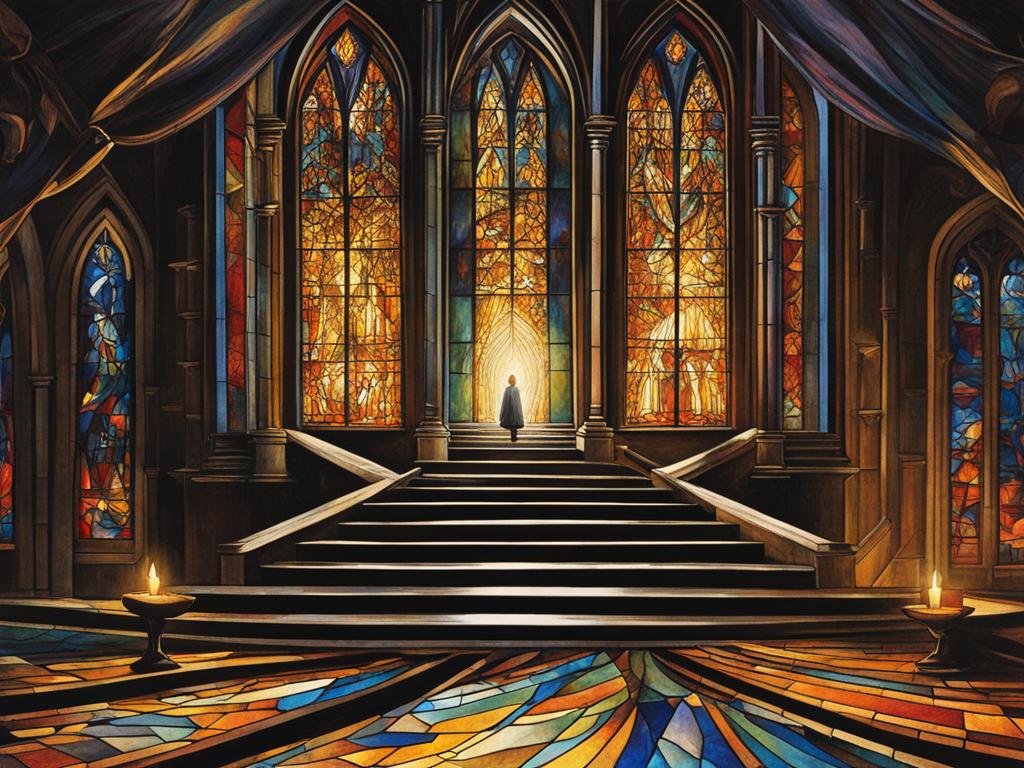No products in the cart.
The Ecstasy of Saint Teresa of Avila
This post contains affiliate links.
The Ecstasy of Saint Teresa is an exquisite sculptural masterpiece created by Gian Lorenzo Bernini. This awe-inspiring work of art, also known as Saint Teresa in Ecstasy or the Transverberation of Saint Teresa, resides in the Cornaro Chapel of the revered Santa Maria della Vittoria church in Rome.
Completed between 1647 and 1652, The Ecstasy of Saint Teresa is a testament to Bernini’s extraordinary skill and craftsmanship, and it stands as one of the crowning achievements of the High Roman Baroque era.
This white marble sculpture depicts Teresa of Ávila, a revered Spanish Carmelite nun and saint, experiencing a profound religious ecstasy while an angel holds a spear above her.
The commission for this remarkable sculpture came from the Venetian Cardinal Federico Cornaro, who chose the Cornaro Chapel in the church of the Discalced Carmelites as the perfect setting for Bernini’s creation.
The chapel had previously housed an image of ‘St. Paul was in Ecstasy before the arrival of Bernini’s masterpiece.
The Ecstasy of Saint Teresa is an exceptional work of artistic genius and a striking example of Bernini’s ability to manipulate light and create the illusion of divine intervention.
The sculpture is bathed in natural light, which delicately filters through a hidden window in the dome above the sculptural group, illuminating the scene with ethereal radiance.
The Cornaro Chapel further enhances the impact of The Ecstasy of Saint Teresa. The side walls of the chapel feature life-size high-relief donor portraits of male members of the illustrious Cornaro family, seemingly engaged in conversation as they witness the transcendent event unfolding.
Above, the chapel’s vault is adorned with a fresco depicting a cherub-filled sky, symbolizing the presence of the Holy Ghost.
Interpretations of The Ecstasy of Saint Teresa vary. Some perceive the theatrical elements within the sculpture, with the Cornaro family taking on the role of attentive spectators in their exclusive boxes.
Others marvel at Bernini’s ability to marry sensual and spiritual pleasure in this impactful artwork, blurring the earthly and divine boundaries.
Key Takeaways:
- The Ecstasy of Saint Teresa is a marble sculpture crafted by Gian Lorenzo Bernini in the Cornaro Chapel of Santa Maria della Vittoria church in Rome.
- Completed between 1647 and 1652, it is regarded as one of the masterpieces of the High Roman Baroque.
- The sculpture depicts the Spanish saint, Saint Teresa of Ávila, experiencing a religious ecstasy, with an angel holding a spear above her.
- Commissioned by Cardinal Federico Cornaro, the sculpture is illuminated by natural light that filters through a hidden window, creating a divine atmosphere.
- The Cornaro Chapel, with donor portraits and cherub-filled frescoes, adds a heightened sense of awe and drama to the sculpture’s setting.
The Creation of the Sculpture
Commissioned by the Venetian Cardinal Federico Cornaro, the sculpture of The Ecstasy of Saint Teresa found its home in the Cornaro Chapel of the church of the Discalced Carmelites. This exquisite masterpiece was crafted by the renowned artist Gian Lorenzo Bernini between 1647 and 1652.
Before creating the final marble version, Bernini first brought the sculpture to life in a tiny terracotta model. This initial embodiment of the project allowed him to refine and perfect every intricate detail before proceeding with the marble sculpture.
| Commission | Gian Lorenzo Bernini | Federico Cornaro | Discalced Carmelites | Terracotta Model |
|---|---|---|---|---|
| Commissioned by the Venetian Cardinal Federico Cornaro | Gian Lorenzo Bernini | Selected Cornaro Chapel in the church of the Discalced Carmelites as the location | Church of the Discalced Carmelites | Created a small terracotta model before proceeding with the final marble version |
The Sculptural Group and Its Setting
The sculptural group of The Ecstasy of Saint Teresa is bathed in the ethereal glow of natural light, filtering through a hidden window in the dome of the surrounding aedicule. This divine illumination emphasizes the heavenly nature of the scene and adds a mystical ambiance to the sculpture.
Set against a backdrop of gilded stucco rays, the statue of Saint Teresa appears as if suspended in mid-air, lying delicately upon a cloud. This positioning symbolizes her transcendent state of ecstasy and her profound connection to the divine.
| Cornaro family | Cherub-filled sky |
|---|---|
| The side walls of the chapel feature life-size high-relief donor portraits of male members of the Cornaro family. These portraits depict the family members discussing the miraculous event, capturing their awe and reverence. | The vault of the chapel is adorned with a spectacular fresco depicting a cherub-filled sky. The illusionistic artwork creates the illusion of a heavenly realm, representing the descending light of the Holy Ghost and underscoring the divine nature of Saint Teresa’s mystical experience. |
The interplay of natural light, gilded stucco rays, depictions of the Cornaro family, and the cherub-filled sky unite to create a truly awe-inspiring setting for the sculpture. This harmonious combination enhances the emotional impact of The Ecstasy of Saint Teresa and invites viewers to transcend earthly boundaries and immerse themselves in a realm of spiritual wonder.
Interpretations and Influences
The sculpture of The Ecstasy of Saint Teresa by Gian Lorenzo Bernini has captivated viewers for centuries and has been subject to various interpretations. One notable aspect that some viewers appreciate is the use of theatrical effects within the sculptural group.
As observers, we can envision the Cornaro family, who commissioned the sculpture, occupying their designated boxes and witnessing the dramatic scene unfold before their eyes. This element adds a sense of spectacle and grandeur to the artwork, elevating it beyond a simple religious representation.
Bernini’s artistic intention in creating The Ecstasy of Saint Teresa was to evoke sensual and spiritual pleasure. The sculpture beautifully intertwines these two aspects, depicting Saint Teresa in a state of religious ecstasy, her body and face visually conveying the intense pleasure she experiences.
This sensual depiction heightens the spiritual significance of the moment, inviting viewers to contemplate the divine and metaphysical aspects of their own lives.
The influence of The Ecstasy of Saint Teresa extends far beyond Bernini’s time. The sculpture has inspired numerous artists and works, both directly and indirectly. For instance, the Czech underground group The Ecstasy of Saint Theresa took their name from Bernini’s masterpiece, drawing inspiration from its themes and profound emotional impact.
Dan Brown’s novel Angels & Demons prominently features the sculpture in the literary realm, weaving its enigmatic presence into a suspenseful narrative. Additionally, the psychoanalytic theories of Jacques Lacan have explored the psychological dimensions of The Ecstasy of Saint Teresa and its representation of desire, pleasure, and the divine.
FAQ
What is The Ecstasy of Saint Teresa?
The Ecstasy of Saint Teresa, also known as Saint Teresa in Ecstasy or the Transverberation of Saint Teresa, is a sculptural group in white marble created by Gian Lorenzo Bernini. It is in the Cornaro Chapel of the Santa Maria della Vittoria church in Rome.
When was The Ecstasy of Saint Teresa created?
Bernini completed the sculpture between 1647 and 1652.
Who commissioned The Ecstasy of Saint Teresa?
The Venetian Cardinal Federico Cornaro commissioned the sculpture.
Where is The Ecstasy of Saint Teresa located?
The sculpture is located in the Cornaro Chapel of the Santa Maria della Vittoria church in Rome.
What is the setting of The Ecstasy of Saint Teresa?
The sculptural group is set in a dramatic scene, with Teresa lying on a cloud to signify a divine apparition. It is illuminated by natural light, which filters through a hidden window in the dome of the surrounding aedicule.
What is the interpretation of The Ecstasy of Saint Teresa?
The sculpture has been interpreted in different ways. Some see the theatrical effects in the sculptural group, with the Cornaro family observing the scene from their boxes. Others highlight the fusion of sensual and spiritual pleasure in Bernini’s artistic intention.
Has The Ecstasy of Saint Teresa influenced other artists and works?
Yes, the sculpture has influenced other artists and works, such as the Czech underground group The Ecstasy of Saint Theresa, the novel Angels & Demons by Dan Brown, and the psychoanalytic theories of Jacques Lacan.
This post contains affiliate links.











